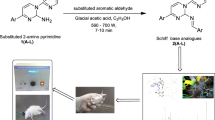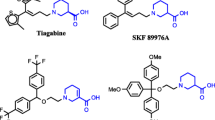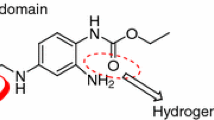Abstract
The aim of this study was to identify compounds that possess anticonvulsant activity by using a pentylenetetrazol (PTZ)-induced seizure model. Theoretical studies of a set of ligands, explored the binding affinities of the ligands for the GABAA receptor (GABAAR), including some benzodiazepines. The ligands satisfy the Lipinski rules and contain a pharmacophore core that has been previously reported to be a GABAAR activator. To select the ligands with the best physicochemical properties, all of the compounds were analyzed by quantum mechanics and the energies of the highest occupied molecular orbital and lowest unoccupied molecular orbital were determined. Docking calculations between the ligands and the GABAAR were used to identify the complexes with the highest Gibbs binding energies. The identified compound D1 (dibenzo(b,f)(1,4)diazocine-6,11(5H,12H)-dione) was synthesized, experimentally tested, and the GABAAR–D1 complex was submitted to 12-ns-long molecular dynamics (MD) simulations to corroborate the binding conformation obtained by docking techniques. MD simulations were also used to analyze the decomposition of the Gibbs binding energy of the residues involved in the stabilization of the complex. To validate our theoretical results, molecular docking and MD simulations were also performed for three reference compounds that are currently in commercial use: clonazepam (CLZ), zolpidem and eszopiclone. The theoretical results show that the GABAAR–D1, and GABAAR–CLZ complexes bind to the benzodiazepine binding site, share a similar map of binding residues, and have similar Gibbs binding energies and entropic components. Experimental studies using a PTZ-induced seizure model showed that D1 possesses similar activity to CLZ, which corroborates the predicted binding free energy identified by theoretical calculations.







Similar content being viewed by others
References
Chebib M, Johnston GAR (1999) The ‘ABC’ of GABA receptors: a brief review. Clin Exp Pharmacol Physiol 26:937–940
Khan ZU, Gutierrez A, De Blas AL (1994) The subunit composition of a GABAA/benzodiazepine receptor from rat cerebellum. J Neurochem 63:371–374
Hanson SM, Morlock EV, Satyshur KA, Czajkowski C (2008) Structural mechanisms underlying benzodiazepine modulation of the GABAA receptor. J Neurosci 28:3490–3499
Duncalfe LL, Dunn SM (1993) Benzodiazepine binding to GABAA receptors: differential effects of sulphydryl modification. Eur J Pharmacol 246:141–148
Sigel E (2002) Mapping of the benzodiazepine recognition site on GABA(A) receptors. Curr Top Med Chem 2:833–839
Rowlett JK, Cook JM, Duke AN, Platt DN (2005) Selective antagonism of GABAA receptor subtypes: an in vivo approach to exploring the therapeutic and side effects of benzodiazepine-type drugs. CNS Spectr 10:40–48
Orser BA (2006) Extrasynaptic GABAA receptors are critical targets for sedative-hypnotic drugs. J Clin Sleep Med 2:S12–S18
Fonlupt P, Croset M, Lagarde M (1990) Benzodiazepine analogues inhibit arachidonate-induced aggregation and thromboxane synthesis in human platelets. Br J Pharmacol 101:920–924
Migliaria O, Plescia S, Diana P, Di Stephano V, Camarda L, Dallolio R (2004) Syntesis and pharmacological evaluation of 7-substitued 1–ethyl–3,4,10–trimethyl–1,10–dihydro–11H-pyrazolo[3,4–c] [1,6]benzodiazocin–11–one: a new ring system. ARKIVOC V:44–53
Koriatopoulou K, Karousis N, Varvounis G (2008) Novel synthesis of the pyrrolo[2,1–c][1, 4]benzodiazocine ring system via a Dieckmann condensation. Tetrahedron 64:10009–10013
Venkatachalan SP, Czajkowski C (2012) Structural link between γ-aminobutyric acid type A (GABAA) receptor agonist binding site and inner β-sheet governs channel activation and allosteric drug modulation. J Biol Chem 287:6714–6724
Morlock EV, Czajkowski C (2011) Different residues in the GABAA receptor benzodiazepine binding pocket mediate benzodiazepine efficacy and binding. Mol Pharmacol 80:14–22
Muroi Y, Czajkowski C, Jackson MB (2006) Local and global ligand-induced changes in the structure of the GABA(A) receptor. Biochemistry 45:7013–7022
Xie HB, Sha Y, Wang J, Cheng MS (2013) Some insights into the binding mechanism of the GABAA receptor: a combined docking and MM-GBSA study. J Mol Model 12:5489–5500
Macías-Pérez ME, Martínez-Ramos F, Padilla-Martínez II, Correa-Basurto J, Kispert L, Mendieta-Wejebe JE, Rosales-Hernández MC (2013) Ethers and esters derived from apocynin avoid the interaction between p47phox and p22phox subunits of NADPH oxidase: evaluation in vitro and in silico. Biosci Rep 33:605–616. doi:10.1042/BSR20130029
Bello M, Martínez-Archundia M, Correa-Basurto J (2013) Automated docking for novel drug discovery. Expert Opin Drug Discov 8:821–834
Lipinski CA, Lombardo F, Dominy BW, Feeney PJ (2001) Experimental and computational approaches to estimate solubility and permeability in drug discovery and development settings. Adv Drug Deliv Rev 46(1–3):3–26
Dalafave DS, Prisco G (2010) Inhibition of antiapoptotic BCL- XL, BCL-2, and MCL-1 proteins by small molecule mimetics. Cancer Inform 9:169–177
Correa-Basurto J, Flores-Sandoval C, Marín-Cruz J, Rojo-Domınguez A, Espinoza-Fonseca LM, Trujillo-Ferrara JG (2007) Docking and quantum mechanic studies on cholinesterases and their inhibitors. Eur J Med Chem 42:10–19
Kollman PA, Massova I, Reyes C, Kuhn B, Huo S, Chong L, Lee M, Lee T, Duan Y, Wang W, Donini O, Cieplak P, Srinivasan Y, Case DA, Cheatham TE III (2000) Calculating structures and free energies of complex molecules: combining molecular mechanics and continuum models. Acc Chem Res 33:889–897
Miller BR, McGee TD, Swails JM, Homeyer N, Gohlke H, Roitberg AE (2012) MMPBSA.py: an efficient program for end-state free energy calculations. J Chem Theory Comput 8(9):3314–3321
Munthe AW, Strandjord RE (1973) Clonazepam in the treatment of epileptic seizures. Acta Neurol Scand Suppl 53:97–102
Martínez C, Rabadán FP, Galán J (1977) Modification of clonazepam anticonvulsive activity by its association with other anti-epileptic drugs. Experientia 33:640–642
Stewart JJP (1989) Optimization of parameters for semiempirical methods I. Method. J Comp Chem 10(2):209–220
Stewart JJP (1989) Optimization of parameters for semiempirical methods II. Applications. J Comp Chem 10:221–264
Becke AD (1993) A new mixing of Hartree–Fock and local density-functional theories. J Chem Phys 98:1372
Lee C, Yang W, Parr RG (1988) Development of the Colle–Salvetti correlation energy formula into a functional of the electron density. Phys Rev B 37:785–789
Godbout N, Salahub D, Andzelm J, Wimmer E (1992) Optimization of Gaussian-type basis sets for local spin density functional calculations. Part I. Boron through neon, optimization technique and validation. Can J Chem 70:560–571
Frisch MJ, Trucks GW, Schlegel HB, Scuseria GE, Robb MA, Cheeseman JR, Scalmani G, Barone V, Mennucci B, Petersson GA, Nakatsuji H, Caricato M, Li X, Hratchian HP, Izmaylov AF, Bloino J, Zheng G, Sonnenberg JL, Hada M, Ehara M, Toyota K, Fukuda R, Hasegawa J, Ishida M, Nakajima T, Honda Y, Kitao O, Nakai H, Vreven T, Montgomery JA Jr, Peralta JE, Ogliaro F, Bearpark M, Heyd JJ, Brothers E, Kudin KN, Staroverov VN, Kobayashi R, Normand J, Raghavachari K, Rendell A, Burant JC, Iyengar SS, Tomasi J, Cossi M, Rega N, Millam NJ, Klene M, Knox JE, Cross JB, Bakken V, Adamo C, Jaramillo J, Gomperts R, Stratmann RE, Yazyev O, Austin AJ, Cammi R, Pomelli C, Ochterski JW, Martin RL, Morokuma K, Zakrzewski VG, Voth GA, Salvador P, Dannenberg JJ, Dapprich S, Daniels AD, Farkas Ö, Foresman JB, Ortiz JV, Cioslowski J, Fox DJ, Gaussian, Inc. (2004) Gaussian 03, revision C.02. Gaussian, Inc., Wallingford, CT
Morris GM, Goodsell DS, Halliday RS, Huey R, Hart WE, Belew RK, Olson AJ (1998) Automated docking using a Lamarckian genetic algorithm and an empirical binding free energy function. J Comp Chem 19:1639–1662
Humphrey W, Dalke A, Schulten K (1996) VMD: visual molecular dynamics. J Mol Graph 14:33–38
MacKerell AD, Bashford D, Bellott M, Dunbrack RL, Evanseck JD, Field MJ, Fischer S, Gao J, Guo H, Ha S, Joseph-McCarthy D, Kuchnir L, Kuczera K, Lau FTK, Mattos C, Michnick S, Ngo T, Nguyen DT, Prodhom B, Reiher WE, Roux B, Schlenkrich JC, Smith R, Stote J, Straub M, Watanabe J, Wirkiewicz-Kuczera DY, Karplus M (1998) All-atom empirical potential for molecular modeling and dynamics studies of proteins. J Phys Chem B 102:3586–3616
Phillips JC, Braun R, Wang W, Gumbart J, Tajkhorshid E, Villa E, Chipot C, Skeel RD, Kalé L, Schulten K (2005) Scalable molecular dynamics with NAMD. J Comput Chem 26:1781–1802
Goodford PJ (1985) A computational procedure for determining energetically favourable binding sites on biologically important macromolecules. J Med Chem 28:849–857
Case DA, Babin V, Berryman JT, Betz RM, Cai Q, Cerutti DS, Cheatham TE III, Darden TA, Duke RE, Gohlke H, Goetz AW, Gusarov S, Homeyer N, Janowski P, Kaus J, Kolossváry I, Kovalenko A, Lee TS, LeGrand S, Luchko T, Luo R, Madej B, Merz KM, Paesani F, Roe DR, Roitberg A, Sagui C, Salomon-Ferrer R, Seabra G, Simmerling CL, Smith W, Swails J, Walker RC, Wang J, Wolf RM, Wu X, Kollman PA (2012) AMBER 12. University of California, San Francisco
Wang M, Cieplak P, Kollman PA (2000) How well does a restrained electrostatic potential (RESP) model perform in calculating conformational energies of organic and biological molecules? J Comput Chem 21:1049–1074
Wang J, Wolf RM, Caldwell JW, Kollman PA, Case DA (2004) Development and testing of a general Amber force field. J Comput Chem 25:1157–1173
Jakalian A, Jack DB, Bayly CI (2002) Fast, efficient generation of high-quality atomic charges. AM1-BCC model: II. Parameterization and validation. J Comput Chem 23:1623–1641
Jorgensen WL, Chandrasekhar J, Madura JD, Impey RW, Klein ML (1983) Comparison of simple potential functions for simulating liquid water. J Chem Phys 79:926–935
Van Gunsteren WF, Berendsen HJC (1997) Algorithm for macromolecular dynamics and constraint dynamics. Mol Phys 34:1311–1327
Darden T, York D, Pedersen L (1993) Particle mesh Ewald-an N.log(N) method for Ewald sums in large systems. J Chem Phys 98:10089–10092
Berendsen HJC, Postma JPM, Van Gunsteren WF, Di Nola A, Haak JR (1984) Molecular dynamics with coupling to an external bath. J Chem Phys 81:3684–3690
DeLano WL (2002) The PyMOL molecular graphics system, DeLano Scientific LLC, San Carlos, CA. http://www.pymol.org
Hawkins GD, Cramer CJ, Truhlar DG (1996) Parametrized models of aqueous free energies of solvation based on pairwise descreening of solute atomic charges from a dielectric medium. J Phys Chem 100:19824–19839
Kuhn B, Kollman PA (2000) Binding of a diverse set of ligands to avidin and streptavidin: an accurate quantitative prediction of their relative affinities by a combination of molecular mechanics and continuum solvent models. J Med Chem 43:3786–3791
Paudler WW, Zeiler AG (1969) Diazocine chemistry. V. Synthesis and rearrangement of dibenzo[b, f] [1, 4]diazocine-6,11(5H,12H)-dione. J Org Chem 34:2138–2140
Venugopalan B, Lyer SS, De Souza NJ (1985) TiCl4-induced functionalization of dibenzo[b, f] [1, 4]diazocine-6,11-(5H,12H)-diones. Heterocycles 23:1425–1430
Marescaux C, Micheletti G, Vergnes M, Depaulis A, Rumbach L, Warter JM (1984) A model of chronic spontaneous petit mal-like seizures in the rat: comparison with pentylenetetrazol-induced seizures. Epilepsia 25:326–331
Schmoll H, Brandan I, Grecksch G, Walker L, Kessler C, Popa A (2003) Kindling status in Sprague-Dawley rats induced by pentylenetetrazole. Am J Pathol 162:1027–1034
López ML, González ME, Neri L, Hong E, Rocha LL (2005) 5-HT1A receptor agonists modify epileptic seizures in three experimental models in rats. Neuropharmacology 49:367–375
Hanson SM, Morlock EV, Satyshur KA, Czajkowski C (2008) Structural requirements for eszopiclone and zolpidem binding to the GABAA receptor are different. J Med Chem 51:7243–7252
Berezhnoy D, Gibbs TT, Farb DH (2009) Docking of 1,4-benzodiazepines in the alpha1/gamma2 GABA(A) receptor modulator site. Mol Pharmacol 76:440–450
Kim KS, Lee JY, Lee SJ, Ha T, Kim DH (1994) On binding forces between aromatic ring and quaternary ammonium compounds. J Am Chem Soc 116:7399–7400
Ehlert FJ, Ragan J, Chen A, Roeske WR, Yamamura HI (1982) Modulation of benzodiazepine receptor binding: insight into pharmacological efficacy. Eur J Pharmacol 78:249–253
Morelli M, Gee KW, Yamamura HI (1982) The effect of GABA on in vitro binding of two novel non-benzodiazepines, PK 8165 and CGS 8216, to benzodiazepine receptors in the rat brain. Life Sci 31:77–81
Calabrese EJ, Baldwin LA (2003) Hormesis: the dose–response revolution. Annu Rev Pharmacol Toxicol 43:175–197
Riccia L, Valotia M, Sgaraglia G, Frosini M (2007) Neuroprotection afforded by diazepam against oxygen/glucose deprivation-induced injury in rat cortical brain slices. Eur J Pharmacol 561:80–84
Kouda K, Iki M (2010) Beneficial effects of mild stress (hermetic effects): dietary restriction and health. J Physiol Anthropol 29:127–132
Calabrese EJ (2010) Hormesis is central to toxicology, pharmacology and risk assessment. Hum Exp Toxicol 29:249–261
Calabrese EJ (2008) An assessment of anxiolytic drug screening tests: hormetic dose responses predominate. Crit Rev Toxicol 36:489–542
Miglaria O, Plescia S, Patrizia D, Di Stefano V, Camarda L, Dall’Olio R (2004) Synthesis and pharmacological evaluation of 7-subsituted 1-ethyl-3,4,10-trimethyl-1,10-dihydro-11H-pyrazolo[3,4-c][1,6]benzodiazocin-11-one. A new ring system. ARKIVOC. V:44–53
Wallace AC, Laskowski RA, Thornton JM (1995) LIGPLOT: a program to generate schematic diagrams of protein–ligand interactions. Protein Eng 8:127–134
Acknowledgments
We thank CONACYT (Grant: 132353), CYTED: 214RT0482 and SIP (project 20140252)-COFAA-PIFI/IPN for financial support. Thanks to Cinthya Czajkowski Ph.D. (University of Wisconsin-Madison) for providing us with the GABAAR coordinate. In memory of Dr. J. Samuel Cruz-Sánchez.
Author information
Authors and Affiliations
Corresponding authors
Electronic supplementary material
Below is the link to the electronic supplementary material.
Rights and permissions
About this article
Cite this article
Saavedra-Vélez, M.V., Correa-Basurto, J., Matus, M.H. et al. Seeking potential anticonvulsant agents that target GABAA receptors using experimental and theoretical procedures. J Comput Aided Mol Des 28, 1217–1232 (2014). https://doi.org/10.1007/s10822-014-9798-z
Received:
Accepted:
Published:
Issue Date:
DOI: https://doi.org/10.1007/s10822-014-9798-z




